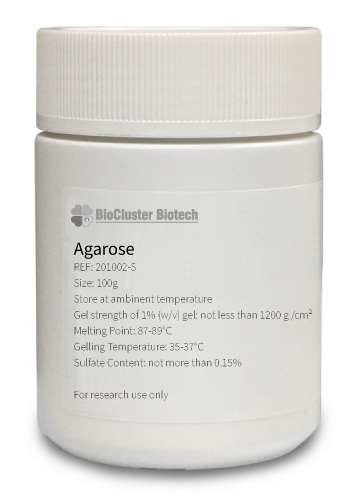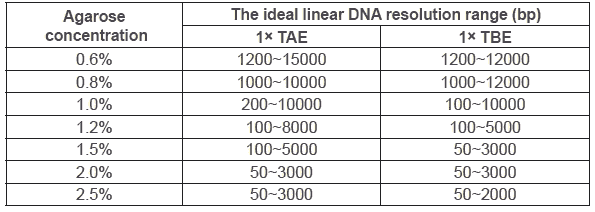Agarose
REF : 201002-S/M

Storage Condition
Components

Description
Quality Control
1. Notes
Gel strength (1% gel): > 1200 g/cm2;
Electro-osmosis(EEO): < 0.15;
Sulfide: ≤ 0.15%;
Gel point (1.5% gel): 35~37℃ ;
Melting point (1.5% gel): 87~89℃ ;
Moisture: ≤ 10%;
No detectable nucleases.
Protocol

2. Method of preparing agarose gel:
❶ Determine the amount of agarose solution needed to cast your gel.
Add buffer (TAE or TBE) into a flask that can hold 2~4 times the volume
of your agarose solution.
Note: The buffer used for making the gel and the electrophoresis buffer should be
the same.
❷ Weigh the required amount of agarose powder, and slowly sprinkle
it into the flask. Cover the mouth of the flask. Place the flask in the
microwave oven and heat the solution until it's boiled. Remove the flask
carefully, and swirl gently to resuspend any agarose particles. Repeat
the above steps for several times, until all the agarose particles are
dissolved.
Note: The agarose should be melted using a method of multiple short boils to
avoid overheating and boiling over. At the same time, the agarose should be
completely dissolved to avoid a blurry gel image.
❸ Add nucleic acid dye to the fully melted agarose.
❹ Pour the agarose solution into the casting tray and insert a comb at an appropriate position. The gel thickness is usually between 3~5 mm.
❺ Let the gel solidify at room temperature (approximately 30 min to 1 h) and then place it in the electrophoresis tank for electrophoresis.
Notice
1. Melting agarose may cause boiling, be careful not to burn yourself.
2. If carcinogenic fluorescent dyes such as ethidium bromide are used for gel nucleic acid staining, gloves should be worn.
3. If the prepared gel is not used immediately, soak the gel in electrophoresis buffer (TAE or TBE) for storage to prevent the gel from drying and cracking.
